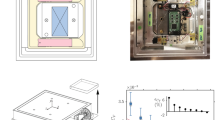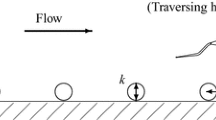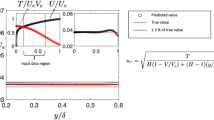Abstract
The mean wall shear stress, \(\overline{\tau }_w\), is a fundamental variable for characterizing turbulent boundary layers. Ideally, \(\overline{\tau }_w\) is measured by a direct means and the use of floating elements has long been proposed. However, previous such devices have proven to be problematic due to low signal-to-noise ratios. In this paper, we present new direct measurements of \(\overline{\tau }_w\) where high signal-to-noise ratios are achieved using a new design of a large-scale floating element with a surface area of 3 m (streamwise) × 1 m (spanwise). These dimensions ensure a strong measurement signal, while any error associated with an integral measurement of \(\overline{\tau }_w\) is negligible in Melbourne’s large-scale turbulent boundary layer facility. Wall-drag induced by both smooth- and rough-wall zero-pressure-gradient flows are considered. Results for the smooth-wall friction coefficient, \(C_f \equiv \overline{\tau }_w/q_{\infty }\), follow a Coles–Fernholz relation \(C_f = \left[ 1/\kappa \ln \left( Re_{\theta }\right) + C\right] ^{-2}\) to within 3 % (\(\kappa = 0.38\) and \(C = 3.7\)) for a momentum thickness-based Reynolds number, \(Re_{\theta } > 15{,}000\). The agreement improves for higher Reynolds numbers to <1 % deviation for \(Re_{\theta } > 38{,}000\). This smooth-wall benchmark verification of the experimental apparatus is critical before attempting any rough-wall studies. For a rough-wall configuration with P36 grit sandpaper, measurements were performed for \(10{,}500< Re_{\theta } < 88{,}500\), for which the wall-drag indicates the anticipated trend from the transitionally to the fully rough regime .














Similar content being viewed by others
Notes
In this paper, the term WSS encompasses the total wall-parallel force, which, for rough-wall flows includes pressure drag of the roughness.
Our value of gravitational acceleration at the University of Melbourne is roughly 0.11 % lower than the standard textbook value of \(9.81\,\hbox {m}/\hbox {s}^2\); note that the Earth’s gravitational field can yield values in the range \(9.81_{-0.5\,\%}^{+0.1\,\%}\,\hbox {m}/\hbox {s}^2\).
References
Acharya M, Bornstein J, Escudier MP, Vokurka V (1985) Development of a floating element for the measurement of surface shear stress. AIAA J 23(3):410–415
Allen JM (1977) Experimental study of error sources in skin-friction balance measurements. J Fluids Eng 99(1):197–204
Allen JM (1980) Improved sensing element for skin-friction balance measurements. AIAA J 18(11):1342–1345
Baars WJ, Talluru KM, Bishop BJ, Hutchins N, Marusic I (2014) Spanwise inclination and meandering of large-scale structures in a high-Reynolds-number turbulent boundary layer. In: Proceedings of 19th Australasian Fluid Mechanics Conference, Melbourne, Australia
Bailey SCC, Hultmark M, Monty JP, Alfredsson PH, Chong MS, Duncan RD, Fransson JHM, Hutchins N, Marusic I, McKeon BJ, Nagib HM, Örlu R, Segalini A, Smits AJ, Vinuesa R (2013) Obtaining accurate mean velocity measurements in high Reynolds number turbulent boundary layers using Pitot tubes. J Fluid Mech 715:642–670
Brown KC, Joubert PN (1969) The measurement of skin friction in turbulet boundary layers with adverse pressure gradients. J Fluid Mech 35:737–757
Chauhan KA, Monkewitz PA, Nagib HM (2009) Criteria for assessing experiments in zero pressure gradient boundary layers. Fluid Dyn Res 41:021404
Colebrook CF (1939) Turbulent flow in pipes, with particular reference to the transition region between the smooth and rough pipe laws. J ICE 11(4):133–156
Fernholz HH, Janke G, Schober M, Wagner PM, Warnack D (1996) New developments and applications of skin-friction measuring techniques. Meas Sci Technol 7:1396–1409
Frei D, Thomann H (1980) Direct measurements of skin friction in a turbulent boundary layer with a strong adverse pressure gradient. J Fluid Mech 101:79–95
George WK (2006) Recent advancements toward the understanding of turbulent boundary layers. AIAA J 44(11):2435–2449
Hakkinen RJ (2004) Reflections on fifty years of skin friction measurement. In: 24th AIAA aerodynamic measurement technology conference, Portland, OR, AIAA 2004–2111
Hanratty TJ, Campbell JA (1996) Measurement of wall shear stress. In: Goldstein RJ (ed) Fluid mechanics measurements. Taylor and Francis, Washington, pp 575–648
Haritonidis JH (1989) The measurement of wall shear stress. In: Gad-el-Hak M (ed) Advances in fluid mechanics measurements. Lecture Notes in Engineering. Springer, Berlin, pp 229–261
Hirt C, Claessens S, Fecher T, Kuhn M, Pail R, Rexer M (2013) New ultrahigh-resolution picture of Earth’s gravity field. Geophys Res Lett 40:4279–4283
Hirt F, Zurfluh U, Thomann H (1986) Skin friction balances for large pressure gradients. Exp Fluids 4:296–300
Klewicki J (2007) Measurement of wall shear stress. In: Tropea C, Yarin AL, Foss JF (eds) Handbook of experimental fluid mechanics. Springer, Berlin, pp 875–886 chapter 12.2
Krogstad PÅ, Efros V (2010) Rough wall skin friction measurements using a high resolution surface balance. Int J Heat Fluid Flow 31:429–433
Löfdahl L, Gad-el-Hak M (1999) MEMS-based pressure and shear stress sensors for turbulent flows. Meas Sci Technol 10:665–686
Lynch RA, Bradley EF (1974) Shearing stress meter. J Appl Meteorol 13:588–591
Marusic I, Monty JP, Hultmark M, Smits AJ (2013) On the logarithmic region in wall turbulence. J Fluid Mech 716(R3):1–11
Marusic I, Chauhan K, Kulandaivelu V, Hutchins N (2015) Evolution of zero-pressure-gradient boundary layers from different tripping conditions. J Fluid Mech 783:379–411
Moody LF (1944) Friction factors for pipe flow. Trans ASME 66(8):671–684
Mori K, Imanishi H, Tsuji Y, Hattori T, Matsubara M, Mochizuki S, Inada M, Kasiwagi T (2009) Direct total skin-friction measurement of a flat plate in zero-pressure-gradient boundary layers. Fluid Dyn Res 41:021406
Nagib H, Christophorou C, Rüedi J, Monkewitz P, Österlund J, Gravante S, Chauhan K, Pelivan I (2004) Can we ever rely on results from wall-bounded turbulent flows without direct measurements of wall shear stress? In: 24th AIAA aerodynamic measurement technology conference, Portland, OR, AIAA 2004–2329
Nagib HM, Chauhan KA, Monkewitz PA (2007) Approach to an asymptotic state for zero pressure gradient turbulent boundary layers. Philos Trans R Soc Lond A 365(1852):755–770
Naughton JW, Sheplak M (2002) Modern developments in shear-stress measurement. Prog Aerosp Sci 38:515–570
Nikuradse J (1950) Laws of flow in rough pipes. Technical memorandum 1292. NACA, Washington
Pujara N, Liu PLF (2014) Direct measurements of local bed shear stress in the presence of pressure gradients. Exp Fluids 55(1767):1–13
Raupach MR, Antonia RA, Rajagopalan S (1991) Rough-wall turbulent boundary layers. Appl Mech Rev 44(1):1–25
Sadr R, Klewicki JC (2000) Surface shear stress measurement system for boundary layer flow over a salt playa. Meas Sci Technol 11:1403–1413
Savill AM, Mumford JC (1988) Manipulation of turbulent boundary layers by outer-layer devices: skin-friction and flow-visualization results. J Fluid Mech 191:389–418
Schetz JA (1997) Direct measurement of skin friction in complex fluid flows. Appl Mech Rev 50(11):198–203
Schetz JA (2004) Direct measurement of skin friction in complex flows using movable wall elements. In: 24th AIAA aerodynamic measurement technology conference, Portland, OR, AIAA 2004–2112
Schlichting H, Gersten K (2000) Boundary layer theory, 8th edn. Springer, Berlin
Squire DT, Morrill-Winter C, Hutchins N, Schultz MP, Klewicki JC, Marusic I (2016) Comparison of turbulent boundary layers over smooth and rough surfaces up to high Reynolds numbers. J Fluid Mech 795:210–240
Stuart IM (1961) Capstan equation for strings with rigidity. Br J Appl Phys 12:559–562
Townsend AA (1976) The structure of turbulent shear flow, 2nd edn. Cambridge University Press, Cambridge
Winter KG (1977) An outline of the techniques available for the measurement of skin friction in turbulent boundary layers. Prog Aerosp Sci 18:1–57
Yang JW, Park H, Chun HH, Ceccio SL, Perlin M, Lee I (2014) Development and performance at high Reynolds number of a skin-friction reducing marine paint using polymer additives. Ocean Eng 84:183–193
Acknowledgments
The authors wish to gratefully acknowledge the Australian Research Council for financial support. Appreciation is expressed to Dr. William T. Hambleton for an initial design of the experimental device at OEM Fabricators Inc. (currently Midwest Mechanics, LCC). We would also like to give special thanks to Dr. Ellen K. Longmire for insightful discussions about the measurement procedure.
Author information
Authors and Affiliations
Corresponding author
Appendix
Appendix
Wall-normal boundary layer profiles of the mean velocity were acquired for both the smooth- and rough-wall configurations. These data allow for an empirical conversion from \(Re_{x} \equiv x_F U_{\infty }/\nu \) to \(Re_{\theta } \equiv \theta U_{\infty }/\nu \), at the position in the Melbourne wind tunnel where these profiles were taken (\(x \approx x_F = 21.0\) m, in the spanwise center). For the smooth-wall case, individual Pitot and static tubes were used to examine the mean velocity. The outside diameter of the Pitot tube was \(d_p = 0.98\) mm and the diameter of the total pressure port was ~0.4 mm. The static tube was positioned 13.5 mm above the Pitot tube, and had an outside diameter of \(d_s = 1.57\) mm, with the static pressure tab positioned 14.2 mm from the leading edge. For dynamic pressures lower than 100 Pa, a 0–1 Torr pressure gauge transducer was used (Table 1). Otherwise, a 0–10 Torr transducer was employed. A logarithmic wall-normal spacing was selected up to the geometric center of the log-region, beyond which linear spacing was used; typical profiles consisted of 60 points. Post-measurement corrections were applied following Bailey et al. (2013) to yield the wall-normal velocity profiles. Profiles above the rough wall were acquired using hot-wire anemometry (Squire et al. 2016). For each \(Re_x\) condition, the momentum thickness was found via numerical integration of the velocity profiles. The obtained \(Re_x \rightarrow Re_{\theta }\) conversions are presented in Fig. 15. An empirical relation of Nagib et al. (2007) is superposed to show its agreement (within experimental tolerance) with our current conversion.
Rights and permissions
About this article
Cite this article
Baars, W.J., Squire, D.T., Talluru, K.M. et al. Wall-drag measurements of smooth- and rough-wall turbulent boundary layers using a floating element. Exp Fluids 57, 90 (2016). https://doi.org/10.1007/s00348-016-2168-y
Received:
Revised:
Accepted:
Published:
DOI: https://doi.org/10.1007/s00348-016-2168-y





